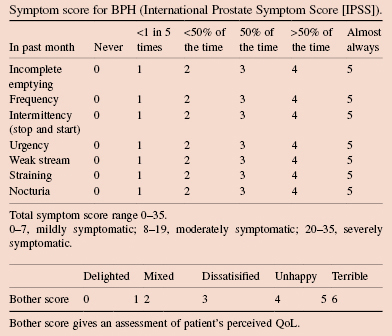Definition
Benign prostatic hypertrophy (BPH) is a condition of unknown aetiology characterized by an increase in size of the inner zone (periurethral glands) of the prostate gland. Lower urinary tract symptoms (LUTS) refers to the voiding dysfunction that results from prostate gland enlargement and bladder outlet obstruction (BOO).
Key Points
- Symptoms of BPH are initially due to obstruction-induced outflow problems, followed by bladder instability and bladder failure.
- Early treatment of symptoms prevents/reverses bladder damage and complications.
- Patients with mild LUTS can be treated with medical therapy.
- Surgical resection is safe but is associated with some significant complications.
Epidemiology
Present in 50% of 60–90-year-old men.
Pathophysiology
- Microscopic stromal nodules develop around the periurethral glands.
- Glandular hyperplasia originates around these nodules.
- As the gland increases in size, it compresses the urethra, leading to urinary tract obstruction and bladder dysfunction.
Clinical Features
Initially outlet obstruction:
- Weak stream, hesitancy, intermittency, dribbling, straining to void, acute urinary retention.
Subsequent detrusor instability:
- Frequency, urgency, nocturia, dysuria, urge incontinence.
Finally detrusor failure and chronic retention:
- Palpable (or percussible) bladder, overflow incontinence.
- Enlarged smooth prostate on digital rectal examination.

Investigations
Basic Investigations
- Urinalysis and urine culture for evidence of infection or haematuria.
- FBC: infection.
- U+E and serum creatinine: renal function.
- PSA: suspicion of underlying malignancy (very non-specific).
Further Investigations
- Voiding diary.
- Uroflowmetry (normal maximum flow rate (Qmax) >15 ml/s) and post-void residual volume measurement (normal <100 ml): evidence of obstruction.
- Ultrasonography of kidneys and bladder: structural abnormalities.
- TRUS: to determine prostate size/biopsy if malignancy suspected.
- IVU: structural abnormalities.
- Cystoscopy.
Stay updated, free articles. Join our Telegram channel

Full access? Get Clinical Tree


